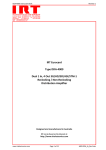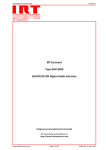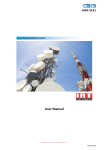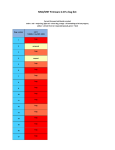Download DVC-4112 User Manual (Revision 01)
Transcript
DVC-4112 270 Mb/s SDI to Composite Converter & DA User Manual IRT Electronics Pty Ltd | www.irtelectronics.com Revision 01 DVC-4112 270 Mb/s SDI to Composite Converter & DA Revision History: Revision 00 01 Date 25/05/2006 05/05/2014 By AL AL Change Description Original Issue. Correction to SK9 output description with LK 3 IN. Applicable to: S/N: ≥ 0601001 S/N: ≥ 0601001 IRT Electronics Pty Ltd | www.irtelectronics.com Page 2 of 13 Revision 01 DVC-4112 USER MANUAL Table of Contents: Section Page Revision History Operational Safety General Description Technical Specifications Configuration Link Settings Installation Digital Video Connections Analogue Output Video Connections Alarm Output Connection Front and rear layouts SNMP – What Is It? DVC-4112 SNMP Functions Maintenance & Storage Warranty & Service 2 4 5 6 7 7 8 8 8 8 9 10 12 13 13 This instruction book applies to units later than S/N: 0601001. IRT Electronics Pty Ltd | www.irtelectronics.com Page 3 of 13 Revision 01 DVC-4112 OPERATIONAL SAFETY WARNING Operation of electronic equipment involves the use of voltages and currents that may be dangerous to human life. Note that under certain conditions dangerous potentials may exist in some circuits when power controls are in the OFF position. Maintenance personnel should observe all safety regulations. Do not make any adjustments inside equipment with power ON unless proper precautions are observed. All internal adjustments should only be made by suitably qualified personnel. All operational adjustments are available externally without the need for removing covers or use of extender cards. IRT Electronics Pty Ltd | www.irtelectronics.com Page 4 of 13 Revision 01 DVC-4112 GENERAL DESCRIPTION BLOCK DIAGRAM DVC-4112 SIGNAL PATH Cable driver Serial Receiver 270Mb SDI Input Automatic Input Equaliser Outputs 4 x Equalised Re-clocked 270Mb SDI Re-Clocker 3 x Composite Component & Composite Encoder DSP SNMP D to A Converter R or Chroma or Pr (V) G or Luma or Y B or Luma or Pb (U) The DVC-4112 is a high performance SDI 270 Mb/s serial digital video to analogue composite/component converter and distribution amplifier. The DVC-4112 is designed to regenerate a link and provide a broadcast quality analogue composite or component signal. The serial receiver section, shown in the block diagram above, automatically equalises and re-clocks the input serial video signal and the cable driver section retransmits the regenerated serial video. This configuration allows both an extension of the link and a jitter performance advantage over non re-clocking regenerators. The DVC-4112 is primarily intended to operate in mixed (digital and analogue) environments allowing existing analogue monitoring equipment to be utilised without the need to purchase more expensive digital equipment. The DVC-4112 provides component outputs for most requirements: RGB, YPbPr and S-VHS (Luma + Chroma). Three composite outputs are always available plus a choice of one of the remaining component formats. Full 10 bit video processing and 10-bit digital to analogue converters are used in order to assure a high quality analogue signal suitable for broadcast and production monitoring applications. Simple Network Management Protocol (SNMP) monitoring is possible if mounted in IRT’s 4000 series frame fitted with SNMP capability. Standard features: • • • • • • • Broadcast quality, full 10-bit video conversion. 4 equalised, regenerated and re-clocked repeater outputs. 3 Composite analogue outputs with high quality 10 bit D to A. Component (RGB, YPbPr) or S-Video (Y/C) output. PAL or NTSC operation with auto or manual switching. SDI input loss and decoded video indicators on front panel. Simple Network Management Protocol (SNMP) capability. IRT Electronics Pty Ltd | www.irtelectronics.com Page 5 of 13 Revision 01 DVC-4112 TECHNICAL SPECIFICATIONS Input: Connector Format Impedance Equalisation BNC. 270 Mb/s SDI (Serial CCIR601, 4:2:2). 75Ω Automatic, better than 200 metres at 270 Mb/s for Belden 8281 or equivalent cable. Outputs - Digital: Number Connectors Format Signal Level 4. BNC. Re-clocked 270 Mb/s SDI (Serial CCIR601, 4:2:2). 800 mV ± 10%. Outputs - Analogue: Number Connectors 3 x composite; plus 1 x RGB / YPbPr / YC component. BNC. Performance: Differential gain Differential phase Luminance non linearity 2T pulse K factor Noise level Hsync jitter in a frame Frame period jitter < 0.5 %. < 0.5°. < 1% p-p. K-2T < 0.5% KF < -80 dBrms (10 kHz - 5 MHz unified). < 3 ns p-p. < 5 ns p-p. Power requirements: Voltage Power consumption 28 Vac CT (14-0-14) or ± 16 Vdc. < 8VA. Other: Temperature range Mechanical Finish: Dimensions Links Front panel Rear assembly 0 - 50° C ambient. Suitable for mounting in IRT 19" rack chassis with input output and power connections on the rear panel. Grey background, black lettering & red IRT logo. Detachable silk-screened PCB with direct mount connectors to Eurocard and external signals. 6 HP x 3 U x 220 mm IRT Eurocard. Component output selection (LK3 & LK4). RGB sync insertion (LK5). NTSC Pedestal insertion (LK6). Digital Noise Reduction (LK7). Digital Noise Shaping (LK8). Pass Vertical Blanking Information (LK9). Due to our policy of continuing development, these specifications are subject to change without notice. IRT Electronics Pty Ltd | www.irtelectronics.com Page 6 of 13 Revision 01 DVC-4112 CONFIGURATION Front Panel Controls & Indicators: NTSC - AUTO -PAL select 270 Mbit PAL 270 Mbit NTSC Loss of input video Power on Component or composite auxiliary outputs: - (default 3 x composite plus 1 x RGB) The DVC-4112 has three dedicated composite outputs. In addition, three analogue outputs are available which are assignable as Y & C (S-Video) or as RGB or YPbPr. The Y & C outputs allow monitors with S-Video inputs or SVHS recorders to be used to best advantage. SW1 PAL, NTSC or Auto configuration Up NTSC Centre Auto (detect) Down PAL Link Settings: Component Output RGB YPbPr YC Link Settings LK3 OUT OUT IN LK4 OUT IN X Output connector assignments: OUT OUT SK 10 SK 11 SK 9 R G B SK9 B/U(Pb) LK 3 LK 4 SK10 LK 3 LK 4 OUT IN SK 10 SK 11 SK 9 Pr Y Pb LK 3 IN SK 10 SK 11 SK 9 Chroma (C) Luminance (Y) (Luminance (Y)) LK 5 LK 5 OUT IN Sync added to ALL component outputs (RGB or YPbPr) No sync on ANY component outputs (RGB or YPbPr) NTSC Pedestal If NTSC format is selected LK 6 LK 6 IN OUT no pedestal pedestal LK 7 LK 7 IN OUT Digital Noise Reduction (DNR) ON Digital Noise Reduction (DNR) OFF LK 8 LK 8 IN OUT Digital Noise Shaping (DNS) ON Digital Noise Shaping (DNS) OFF LK 9 LK 9 IN OUT Pass Vertical Blanking Interval (VBI) Blank Vertical Blanking Interval (VBI) G/Luma/Y SK11 R/Chroma/V(Pr) RGB / YPbPr Sync Digital Noise Reduction Digital Noise Shaping Vertical Blanking Interval IRT Electronics Pty Ltd | www.irtelectronics.com Page 7 of 13 Revision 01 DVC-4112 INSTALLATION Pre-installation: Handling: This equipment may contain or be connected to static sensitive devices and proper static free handling precautions should be observed. Where individual circuit cards are stored, they should be placed in antistatic bags. Proper antistatic procedures should be followed when inserting or removing cards from these bags. Power: AC mains supply: Ensure that operating voltage of unit and local supply voltage match and that correct rating fuse is installed for local supply. DC supply: Ensure that the correct polarity is observed and that DC supply voltage is maintained within the operating range specified. Earthing: The earth path is dependent on the type of frame selected. In every case particular care should be taken to ensure that the frame is connected to earth for safety reasons. See frame manual for details. Signal earth: For safety reasons a connection is made between signal earth and chassis earth. No attempt should be made to break this connection. Installation in frame or chassis: See details in separate manual for selected frame type. Digital Video Connections: SDI Input and outputs are 75 BNC type for connection with high quality 75 coaxial cable. Input is selfterminating. No loop through facility is available. Analogue Output Video Connections: The DVC-4112 comes setup for 3 composite outputs and one RGB component output as standard, all of which are 75 BNC type for connection with high quality 75 coaxial cable. Links LK3 and LK4 change the RGB output to either YPbPr or YC + an extra composite. See Configuration section for link set-ups. Alarm Output Connection: A 2 pin phoenix style screw connector is provide on the rear assembly for an alarm connection for loss of SDI input or loss of power. The output of this is either a switch to ground or switch from ground, depending on the position of link LK11 being in the normally closed (n.c.) or normally open (n.o.) position, respectively. IRT Electronics Pty Ltd | www.irtelectronics.com Page 8 of 13 Revision 01 DVC-4112 Front & rear panel connector diagrams: IRT Electronics Pty Ltd | www.irtelectronics.com Page 9 of 13 Revision 01 DVC-4112 SNMP What Is It? SNMP stands for Simple Network Management Protocol. It is an application layer protocol for managing IP (Internet Protocol) based systems. SNMP enables system administrators to manage system performance, and to find and solve system problems. SNMP runs over UDP (User Datagram Protocol), which in turn runs over IP. Three types of SNMP exist: SNMP version 1 (SNMPv1), SNMP version 2 (SNMPv2) and SNMP version 3 (SNMPv3). It is not the intention here to discuss the differences between various versions, only to bring attention to the fact that IRT Electronics modules, fitted with SNMP capability, use SNMPv1. An SNMP managed network consists of three key components: Network Management Systems (NMS), agents, and managed devices. An NMS is the console through which the network administrator performs network management functions, such as monitoring status (e.g. alarm states) and remote controlling, of a set of managed devices. One or more NMS’s must exist on any managed network. Generally the NMS is a computer running third party SNMP control software. There are a number of third party SNMP software applications currently available on the market. An NMS polls, or communicates with, an agent. An agent is a network management software module that resides in a managed device. An agent has local knowledge of management information and translates that information into a form compatible with SNMP. The agent, therefore, acts as an interface between the NMS and the managed devices. The NMS sends a request message, and control commands for the managed devices, to the agent, which in turn sends a response message, containing information about the managed devices, back to the NMS. A managed device contains an SNMP agent and resides on a managed network. Managed devices collect and store management information and make this information available to NMS’s using SNMP. Managed device agent variables are organised in a tree structure known as a Management Information Base (MIB). Within the MIB are parameters pertaining to the managed device. An Object Identifier (OID) number within the MIB defines the managed device type. This is a unique number specific to the model of managed device. Other information relating to the device is also stored, information such as alarm states, controllable settings, etc. The MIB tree is organised in such a way that there will be no two MIB files with conflicting placements. Normally an NMS polls an agent for information relating to the MIB in a managed device to be sent back to the NMS. When certain conditions are met within the MIB, such as major alarm conditions, for example, the agent automatically sends what is known as a trap to the NMS without any prompting from the NMS. This allows automatic notification of a predetermined event. SNMP Block Diagram NMS IP Network NMS SNMP Agent Protocol Engine MIB SNMP Agent SNMP Agent Protocol Engine MIB SNMP Agent SNMP Agent Protocol Engine MIB SNMP Agent IRT Electronics Pty Ltd | www.irtelectronics.com Page 10 of 13 Revision 01 DVC-4112 SNMP with IRT Products: IRT Electronics currently employs SNMPv1 with its SNMP capable frames. The frame acts as an agent when fitted with a CDM-xxxx module. This module has its own designated slot next to the power supply so as to not affect the number of modules that the frame will take. Communication between the NMS, the frame and its loaded modules are via this CDM-xxxx module. Note that the NMS software is third party and not supplied by IRT Electronics. Ethernet connection for SNMP operation is via an RJ45 connector on the rear of the frame, below the mains inlet. Ethernet rate runs at either 10 baseT or 100 baseT. Frame parameters, such as Name, Address and Location, are set via an RS232 interface, a D9 connector on the rear of the frame below the mains inlet. A software terminal emulator, such as Tera Term or HyperTerminal, is used for setting and reading the parameters of the frame. IRT modules that are SNMP compatible need a plug-in SMU-4000 module with a program relevant to the module that it is plugged into. Depending on the module, besides the module identification, parameters such as alarm states, inputs and controls etc. are communicated to the CDM-xxxx agent via a data bus on the rear of the frame. Thus the CDM-xxxx collects information on what is loaded within the frame, what positions they occupy, and their current status for communication to the NMS when the NMS sends a request for information. In the event of a major alarm from any of the SNMP compatible modules, or power supplies, a trap is automatically sent by the CDM-xxxx agent to the NMS without any prompting by the NMS. This alerts the operator to any fault conditions that may exist that need immediate attention. 110/240 V 50/60 Hz 0.7 A (max.) FRU-4000 FRAME FUSES 220/240 Vac 500 mA S.B. 110/120 Vac 1A S.B. RS232 Alarm Ethernet + 48Vdc AS3260 approval no.: CS6346N Ass. no.: 804692 IRT SNMP Connections NMS Ethernet Cable IP Network IRT modules fitted with SMU-4000 CDM-xxxx PSU’s IRT SNMP Frame Ethernet Cable IRT modules fitted with SMU-4000 CDM-xxxx PSU’s IRT SNMP Frame Ethernet Cable IRT SNMP Setup IRT Electronics Pty Ltd | www.irtelectronics.com Page 11 of 13 Revision 01 DVC-4112 DVC-4112 SNMP Functions: When installed in an IRT frame with SNMP capability, the DVC-4112 can be interrogated by an SNMP Network Management System (NMS). The following SNMP functions are capable of being monitored by an NMS: An indication that the video input is present and whether it is PAL or NTSC; An indication of the output video format, whether it be YC, YPbPr, or RGB; An indication, if the output is RGB, if sync is added to each output; An indication, if the video system is NTSC, if the NTSC Pedestal is on or off; An indication whether vertical interval will be passed or blanked; Whether “Trap” function is enabled; Trap automatically sent, if enabled, if the input signal fails; Unit reset control. IRT Electronics Pty Ltd | www.irtelectronics.com Page 12 of 13 Revision 01 DVC-4112 MAINTENANCE & STORAGE Maintenance: No regular maintenance is required. Care however should be taken to ensure that all connectors are kept clean and free from contamination of any kind. This is especially important in fibre optic equipment where cleanliness of optical connections is critical to performance. Storage: If the equipment is not to be used for an extended period, it is recommended the whole unit be placed in a sealed plastic bag to prevent dust contamination. In areas of high humidity a suitably sized bag of silica gel should be included to deter corrosion. Where individual circuit cards are stored, they should be placed in antistatic bags. Proper antistatic procedures should be followed when inserting or removing cards from these bags. WARRANTY & SERVICE Equipment is covered by a limited warranty period of three years from date of first delivery unless contrary conditions apply under a particular contract of supply. For situations when “No Fault Found” for repairs, a minimum charge of 1 hour’s labour, at IRT’s current labour charge rate, will apply, whether the equipment is within the warranty period or not. Equipment warranty is limited to faults attributable to defects in original design or manufacture. Warranty on components shall be extended by IRT only to the extent obtainable from the component supplier. Equipment return: Before arranging service, ensure that the fault is in the unit to be serviced and not in associated equipment. If possible, confirm this by substitution. Before returning equipment contact should be made with IRT or your local agent to determine whether the equipment can be serviced in the field or should be returned for repair. The equipment should be properly packed for return observing antistatic procedures. The following information should accompany the unit to be returned: 1. 2. 3. 4. 5. 6. 7. A fault report should be included indicating the nature of the fault The operating conditions under which the fault initially occurred. Any additional information, which may be of assistance in fault location and remedy. A contact name and telephone and fax numbers. Details of payment method for items not covered by warranty. Full return address. For situations when “No Fault Found” for repairs, a minimum charge of 1 hour’s labour will apply, whether the equipment is within the warranty period or not. Contact IRT for current hourly rate. Please note that all freight charges are the responsibility of the customer. The equipment should be returned to the agent who originally supplied the equipment or, where this is not possible, to IRT directly. Details of IRT’s direct address can be found at IRT Electronics’ website. Web address: www.irtelectronics.com Email: [email protected] IRT Electronics Pty Ltd | www.irtelectronics.com Page 13 of 13 Revision 01
























